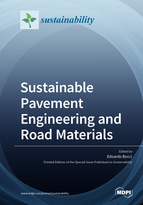Sustainable Pavement Engineering and Road Materials
A special issue of Sustainability (ISSN 2071-1050). This special issue belongs to the section "Sustainable Engineering and Science".
Deadline for manuscript submissions: closed (30 September 2021) | Viewed by 44406
Special Issue Editor
Interests: hot and cold recycling; waste materials in bituminous mixtures; clear binders; linear viscoelasticity and damage modeling; orthotropic steel deck pavements
Special Issues, Collections and Topics in MDPI journals
Special Issue Information
Dear Colleagues,
Similarly to many other engineering fields, road pavement industry strongly affects the critical issues of our generation, such as climate change, pollutant emission, exploitation of natural resources, and the economic crisis. For this reason, technicians and researchers are ravenously looking for sustainable solutions to be implemented in the current road construction system, with the goal:
- to reduce the consumption of energy and virgin materials;
- to run environmentally and economically friendly maintenance;
- to recycle wastes from different industrial processes;
- to decrease the noise, the pollution and the heat generated by traffic, particularly in urban contexts.
This Special Issue aims to collect worthy studies that combine the aforementioned solutions dealing with:
- Hot, warm, and cold recycling of reclaimed asphalt pavement;
- Marginal materials for asphalt pavements;
- Innovative sustainable materials;
- Durability and environmental aspects;
- Structure performance, modeling, and design;
- Advanced trends in rehabilitation and preservation;
- Surface characteristics and road safety;
- Management system/life cycle analysis;
- Urban heat island mitigation;
- Energy harvesting.
Original papers related to the above topics and also dealing generally with methodologies, case studies, simulations, and experimental testing are welcome.
Thank you for your contributions.
Dr. Edoardo Bocci
Guest Editor
Manuscript Submission Information
Manuscripts should be submitted online at www.mdpi.com by registering and logging in to this website. Once you are registered, click here to go to the submission form. Manuscripts can be submitted until the deadline. All submissions that pass pre-check are peer-reviewed. Accepted papers will be published continuously in the journal (as soon as accepted) and will be listed together on the special issue website. Research articles, review articles as well as short communications are invited. For planned papers, a title and short abstract (about 100 words) can be sent to the Editorial Office for announcement on this website.
Submitted manuscripts should not have been published previously, nor be under consideration for publication elsewhere (except conference proceedings papers). All manuscripts are thoroughly refereed through a single-blind peer-review process. A guide for authors and other relevant information for submission of manuscripts is available on the Instructions for Authors page. Sustainability is an international peer-reviewed open access semimonthly journal published by MDPI.
Please visit the Instructions for Authors page before submitting a manuscript. The Article Processing Charge (APC) for publication in this open access journal is 2400 CHF (Swiss Francs). Submitted papers should be well formatted and use good English. Authors may use MDPI's English editing service prior to publication or during author revisions.
Keywords
- Sustainable materials
- Recycling
- Environmental impact reduction
- Durability
- Road safety
- Sustainable design and construction
- Sustainable maintenance






